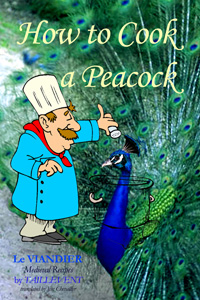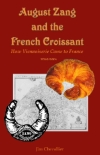CHEZ JIM
BOOKS |
Catholic Fasting in France
Eighteenth Century |

|
Because, according to Genesis, both were created on the same day.
When monks were allowed to use it on "meatless days".
Depends on the century. |
"The history of a people's customs is only, strictly speaking, the history of its contradictions."
Legrand on Fasting
"It is not surprising that, in a work on the history of French food, Le Grand addresses the issue of Catholic fasting. The distinction between meat (gras, or “fat”) and meager or meatless (maigre, or “lean”) foods was central under the French monarchy; it is referenced all through period recipe books and was enforced by law. What is more surprising is that, rather than devoting a separate chapter to the subject, Le Grand has scattered his comments through four different chapters, sometimes shamelessly digressing from a chapter's main subject to explore the intricacies of this history. The translation offered here combines – with minimal editing for flow – sections from the chapters on “Poultry”, “Eggs, Cheese, Butter and Milk”, “Fish” and “Prepared Dishes” respectively. Taken together, these passages present an unusually concise and reasonably comprehensive overview of the history of Catholic fasting in Old Regime France. Often too, this material is colorful and diverting. Le Grand, though a former Jesuit, shows evident amusement at the contortions of logic some used to eat meat while classifying it as something else. One of the most striking aspects of this complex and shifting history is the diversity of foods – poultry, animal fat, even hash – which were considered acceptable fast foods at different points in Catholic history."
|
Some samples from the book"Anyone who has read a little knows that, for a long time, and since the fourth century, Christians regarded flying creatures and poultry as meager foods; and that as a result they allowed themselves the one like the other without scruple during times of the year when meat is forbidden. They distinguished the flesh of quadrupeds from the flesh of birds; and this gentle error had for them a respectable authority: that of the holy books themselves. Genesis, speaking of Creation, says that, on the fifth day, God commanded the waters to produce fish and the birds who fly on the Earth. This text, misunderstood, served to give the same origin to two such different species of animal; they were supposed as a result to have the same nature, and it was thought one could equally use the one or the other on days of abstinence. (a). Several Church Fathers, St. Basil, St. Ambrose, etc., even authorized this decision by their reasoning. (a) Alii, says the historian Socrates [born c. 380], ab animatis penitus abstinent; alii ex animantibus pisces solos comedunt. Nonnuli, cum piscibus, etiam avibus vescuntur; ex aquis, ut est apud Moysen, eat quoque conditas esse affirmantes. [“Others completely abstain from living things; others of animals eat only fish. Some, with fish, feed upon birds, which according to Moses were also created from water.”] In France, it was regarded as an unquestionable principle; even by the most austere Religious Order, among those devoted to a perpetual Lent. At certain times of year, game and poultry were allowed the Monks. St. Columban so fed his people in a moment of shortage. Carnem quadrupedum, à die conversioniis sua usque ad extremum vitae, edere noluit: Jus e pullo compositum sumebat, si aliqua accessisset debilitas, [“For the day of his conversion to the end of his life he would not eat the meat of quadrupeds: if he felt weak, he took chicken broth.”] says the life of St. Benedict of Aniane. One reads in that of St. Eloi that, since his promotion to the Bishopric, he had given up eating meat; but that one day he allowed himself to eat a fowl with a guest who had arrived. Gregory of Tours tells how in eating at Chilperic's table, and he not using meat either, the King told him: Eat this soup; it is for you, it has been made with fowl. Finally in a large number of old lives of Saints, it is said of them, that as a particular mortification, they abstained, not only from meat, but from poultry and two-footed game..." 'The Catholic Faithful follow, in their way of living, several commendable regimes; because some abstain not only from the flesh of quadrupeds, of birds, and of fish, but also from eggs and cheese; others give up only quadrupeds, and allow themselves birds and all other foods. Some eat no flying creatures; but they eat eggs, and fish. Others forbid themselves eggs. There are those who only use fish; there are those who, abstaining from fish, eat cheese, of which others deprive themselves. Finally, some reject bread; and others, the fruits of trees, as well as all cooked foods.'..." |
Table of Contents
|
About Le Grand's Work"The current volume has been extracted, translated and retitled from Pierre Jean-Baptiste Le Grand d'Aussy's classic work on French food and drink, which has come down to us with the slightly misleading title of Histoire de la vie privée des Français depuis l’origine de la nation jusqu’à nos jours; that is, “History of the private life of the French from the origin of the nation until our days”. Though Le Grand originally intended to produce such a comprehensive work, in practice he only finished the three volumes on food and drink (first published in 1783). Incomplete as these may be in terms of the overall project, they are almost manically thorough in their examination of the specific subject and have remained, over the centuries, some of the prime sources on the subject. Not only do even modern writers continue to draw on them for key information, more than one writer (in both French and English) has shamelessly copied whole stretches of Le Grand's work, well after it was written, and presented it as their own. ...He is, in a word, not only an informative but a lively and enjoyable writer, but one who, in English, is more often cited than translated at length. The present effort is intended to remedy that, if only in small measure." |
All text and translations copyright 2011 Jim Chevallier.
Please do not reproduce or post elsewhere without prior permission.
Interested in the history of food and drink? Here are four other books from Chez Jim:
|
Yes,
the French kings really did eat peacocks - and swans, and herons, and
blackbirds too. Taillevent, the cook who served two of them, not only cooked
these dishes, but left a book on how to do it. He called it Le Viandier.
In this new translation, it's called: How To
Cook A Peacock ·
For recreational
medievalists ·
For lovers of
culinary history ·
For students of
medieval life ·
For adventurous cooks
|
Have you ever wanted to make an eighteenth century meal? This book, starting with a menu from a classic French cookbook, tells you how. Even if you don't have a house full of servants and a kitchen with numerous hearths, you'll find enough original French eighteenth century recipes - newly translated - here to entertain a number of guests in true eighteenth century style. This collection includes recipes for game, veal, beef, chicken and various sauces, salads and other tasty items, worth making on their own or as part of a full, elegant period meal. |
The second volume in this series presents VEGETARIAN recipes from Old Regime France. No, it's not a modern gimmick - in Catholic France, meat was forbidden on some days, and so one of the choices was this "meal of roots"; including not only carrots, parsnips, beets, turnips, etc., but also lentils and peas, onions, artichokes and asparagus. This collection includes over 100 recipes for soups, stews, salads, sweets, even... mock fish, made from vegetables of every sort (and even a fish or two). |
The story of how the croissant actually came to France is far more interesting than myths about Marie-Antoinette and a siege of Vienna. The story of how viennoiserie came to France is also that of an Austrian entrepreneur who changed French baking forever before going back to Vienna and doing the same for the Austrian press.
|
UPDATED: August 20, 2022



